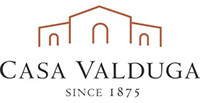
130
Brut Rosé
NV | 750 mL
In 2005, with the goal of creating Brazil's iconic sparkling wine, Casa Valduga commemorated 130 years since the arrival of the Italian family in Brazil with the production of this unrivaled Brut 130. In 2018, line 130 gains one more copy, the 130 Brut Rosé, demonstrating that the classic can be reinvented.
- Sparkling Wine Brut Rosé
- Chardonnay e Pinot Noir
- 36 months causing yeast autolysis
- Vale dos Vinhedos
- 6º to 8ºC
- Guard until 4 years after dégorgement. Provided it is maintained in the right conditions for full development
- Fish, seafood, japanese food, risottos and appetizer
Produced from special vintages of the grapes Chardonnay and Pinot Noir, through the champenoise method, remains in yeast autolysis for 36 months.
Appereance: Luminous, it has salmon coloration, with fine and delicate perlage, forming a generous crown.
Bouquet: The bouquet is expressive, denoting candied fruit and cherry liqueur, along the tasting notes of its maturation reveal almonds and brioche.
Palate: On the palate, its creaminess and elegance stand out along with the vibrant and juicy acidity, combined with the aftertaste evidenced by the buttery touches.
-
 Gran Gold Concurso do Espumante Brasileiro | Brasil | 2021 NV
Gran Gold Concurso do Espumante Brasileiro | Brasil | 2021 NV -
 Double Gold Vinus | Argentina | 2021 NV
Double Gold Vinus | Argentina | 2021 NV -
 93 Points Guia Descorchados | Chile | 2022 NV
93 Points Guia Descorchados | Chile | 2022 NV
Technical sheet
Varietal Clone: Entav 96 | Mira 130
Rootstock: SO4 | 3309
Production system: Simple Espalier
Production system: Simple Espalier
Density/ha: 4.000
Type of prunning: Spur Cord
Gems Load/ha: 60.000
Type of prunning: Spur Cord
Gems Load/ha: 60.000
Harvest: Manual and selective
Winemaking
Traditional Method
Production of base wine
- Final selection of bunches;
- Direct pressing of the grapes (Chardonnay) - press with inert atmosphere;
- Destemming and maceration from 6h to 8h (Pinot Noir);
- Clarification of the must;
- Use of selected yeasts Saccharomyces cerevisiae;
- Alcoholic fermentation with temperature 15 ° C to 16ºC;
- Blend of Chardonnay and Pinot Noir;
- Tartaric stabilization;
- Filtration;
Second fermentation
- Use of selected yeasts;
- Tirage liqueur;
- Filling;
- Second fermentation inside the bottle at a temperature of 12ºC;
- Filtration;
- Matured for 36 months causing yeast autolysis;
- Riddling in pupitres;
- Degorgement, addition of expedition liqueur, corking and labeling.
Production of base wine
- Final selection of bunches;
- Direct pressing of the grapes (Chardonnay) - press with inert atmosphere;
- Destemming and maceration from 6h to 8h (Pinot Noir);
- Clarification of the must;
- Use of selected yeasts Saccharomyces cerevisiae;
- Alcoholic fermentation with temperature 15 ° C to 16ºC;
- Blend of Chardonnay and Pinot Noir;
- Tartaric stabilization;
- Filtration;
Second fermentation
- Use of selected yeasts;
- Tirage liqueur;
- Filling;
- Second fermentation inside the bottle at a temperature of 12ºC;
- Filtration;
- Matured for 36 months causing yeast autolysis;
- Riddling in pupitres;
- Degorgement, addition of expedition liqueur, corking and labeling.
Analytical report
Alcohol: according to the label
Total Acidity: 6,97 g/L of acid tartaric
Total Acidity: 6,97 g/L of acid tartaric
Volatile Acidity: 0,21 g/L of acid acetic
Density: 0,996
Dry extract: 30,2 g/L
So2 Total/Free: 0,087 / 0,015 g/L
Total sugars: 10,7 g/L
pH: 3,20
Pressure: 5,5 kg/cm2
